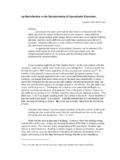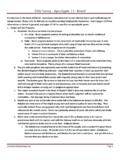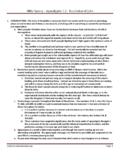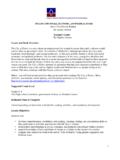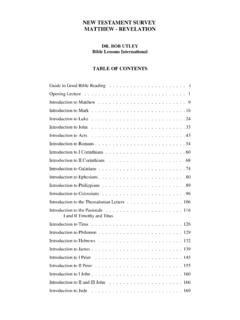Transcription of PB Tom Long Sept2011 - Guildford Baptist Church
1 WhatTomLong has taught me about minutes on Tom long :how do you make a long story short?Some of you might not know who Tom long is:he will be 65 in October,comesfrom Georgia in the American South, where he teaches preaching at CandlerSchool of Theology in Atlanta, he has also taught at Princeton Seminary andwritten a stack of books.(Including the textbook The Witness of Preaching. )Michael Quicke describes long as a very sane voice in homiletics .1. Witness is a wonderful one word summary ofLong s approach topreaching; he organises his whole approach to preaching aroundthis biblicalconcept. Before a preachersayssomething a preacher be a preacher is to be called to be a witness, one who seesbefore speaking, one whose right to speak is created by what is pulpits are used as lecterns, but that is not what they really is not a lectern or a podium; it is a witness stand, and thepreacher s task is to tell the truth, the whole truth, and nothing butthe truth about what is seen.
2 long talks about: The claim of the text what it is demanding of us? The claim of the text is very occasion specific; it is what we hearon this day, from this text, for these people, in thesecircumstances at this juncture in their lives . of course says something about the importance ofScriptureLong views the preaching of Jesus first sermonin Luke 4as a biblical sermonthat isnormative for current practice; the yardstick by which all otherpreaching is assumption is based on the sermon preachedby Jesus in Luke 4, which has its roots in a biblical text from the Book of Isaiah. Preaching that involves significant engagement with a biblical text isthe standard by which all other types of sermon are measured.
3 long in his Foreword to Mike Graves bookThe Sermon as Symphony: When the voltage drops in the Bible, preachers desperately plug thesermon into any outlet that promises a jolt of somepreachers who proclaim that they are Bible preachers ..uponanalysis turn out to preach sermons long on dogmatics and moralismsbut innocent of any serious interaction with a biblical text. long is amodelof a preacherLiving in the Text inhabiting its involves us in the process of askingquestions: long has a lively, active, imaginative and inquisitive The art of biblical exegesis, put simply,involves learninghow to ask questions of a biblical text.
4 Getting to know a biblical text is much like getting to know anotherperson must be with them long enough, and attend to themcarefully enough, to know not only who they are at the moment but also whothey have been in the past and the vision towards which they are moving. Wemust ask them questions and tell them about our own life, but we must not doall the talking. We must listen to them unselfishly, cherishing their word evenwhen it does not connect immediately to our own desires and must observe them in their many different situations, learning about theirvalues and commitments as we see them in action. We must discover thepatterns, customs, and even the habits around which they organise their we look at them and only see our own reflection, we do not know when we know who they are with us can we claim really to know them.
5 If there is a secret to getting involved with God through the pages ofScripture, then perhaps it is this:turn the pages expected word can jar us onto a completely different track. Often when readingone portion of scripture, we run across words that echo another passage. Thus thebiblical writers lead us superbly to make connections between events in the text andlikewise between events in our lives that we had never previously imagined . brings us to long s concept ofFocus and FunctionAfocus statementis a concise description of the central controlling, andunifying theme of the short, this is what the whole sermon will be about.
6 Afunction statementis a description of what he preacher hopes the sermonwill create or cause to happen for the The function statementnames the hoped for change. The idea that the biblical writers were not just trying tosaysomethingwith words but also trying todosomething opened upexciting avenues of textual understanding. The writers of the Bible wereno mere chroniclers; they were, in a way, preachers who chose and arrangedlanguage not only for its content but for its must place theexegetical needle in the grooves of the text, track its movements and contours,and think about sermons as regenerations of the textual event.
7 What is it saying?What is it doing? Will my sermon on this text say and do the same things? long form is not neutral: Form is an essential part of a sermon s content and can itselfsupport or undermine the communication of the gospel. The shape of the witness s sermonshould fit the character of thetestimony .Here long is building on the work of Karl writing in his bookHomileticsclaims that Preaching must not be a welling up out of ourown speech. In both form and content it must be an exposition ofscripture. Barth talks about following the way of witness of the text .This would appear to be the heart of a biblical theology of preaching as witness, it reflects the idea that the preacher is echoing another voice.
8 Agreat deal of homiletic thinking concentrates on helping the preacher find his orher voice,maybe the more appropriate task is to help the preacher find anothervoice in voice is of course echoed in dozens of humanvoices that bring us the preachers mustfirstbe good that each biblical genre has a distinctive tone of voice.(LongPreaching and the Literary Forms of the Bible)Anexample of the impact on mypreachingis a series of sermons on the Bookof Revelation. In this series I have attempted to reflect the powerful imageryof the text by preaching sermons that resemble averbal filmstrip. In thisway the message is crafted to mirror the frame by frame movement of thevisions in John s apocalypse.
9 Such an approach to apocalyptic literature helpsthe hearer to both understand what is said and feel it impact on the senses. Inshaping this series I was talking a cue from long s insights in his articleThePreacher and the argues that preaching on apocalyptic materialrequires a reshaping of homiletic assumptions; rigid sermon forms will not beable to cope with the kind of material found in books like Revelation. Longtreats the material in The Book of Revelation as, perfomative language ;thiswas the clue have found that attention to the genre of the textgives greater scope for communicating its message in a way that helps peopleexperience its message in a full-orbed goes to the Bible in search ofwhatto preachbut does not lingerlong enough to learnhowto preachhas left its pages too soon.
10 Craddock6. long has introduced me to a number of great friends: one of thebest friends I have made from a preaching perspective is Augustine;1500 years stand between us but I have foundhis little book on TeachingChristianity one of the most helpful books I have read. There are two things on which the interpretation of scripturedepends: the process of discovering what we need to learn, and theprocess of presenting what we have learnt. Yet Augustine warns readers concerning an overemphasis on style: There is a danger of forgetting what one has to say while working outa clever way to say it. Teach, Delight and PersuadeState, Illustrate and ApplySermon on the MountExample: Matthew 5:13-16My reflection on long has stimulated me to move beyond seeing preaching asprimarilyeducational and informativeto seeing preaching as engaging thewhole person in a transformative way.
